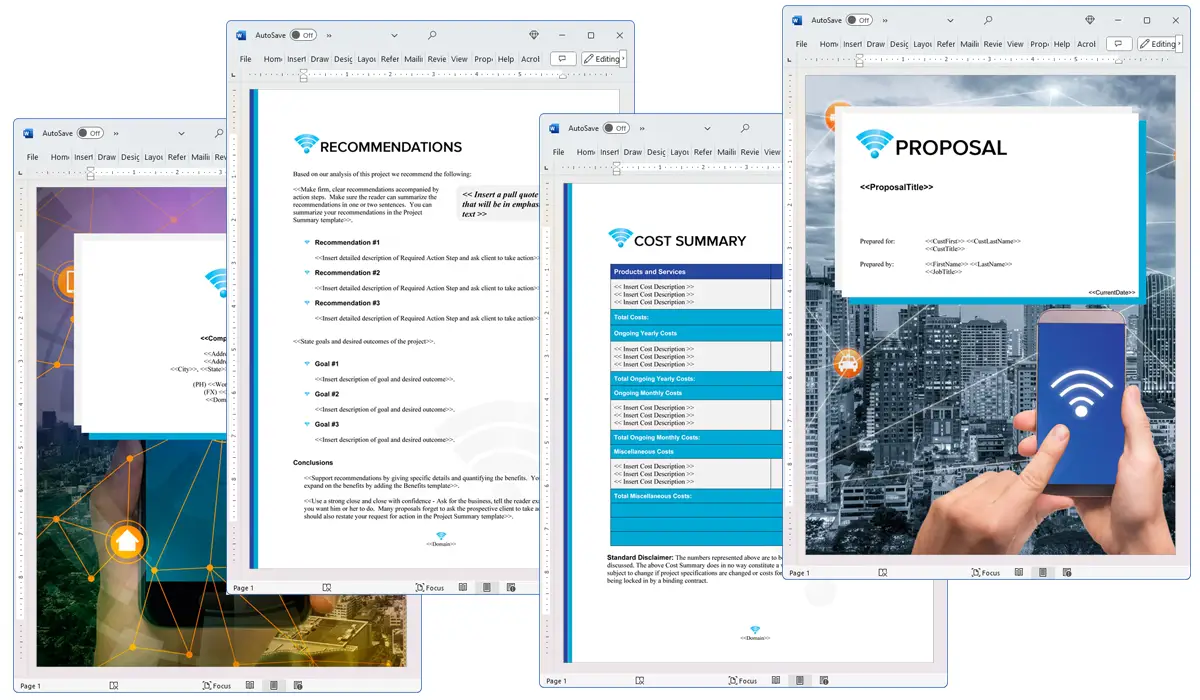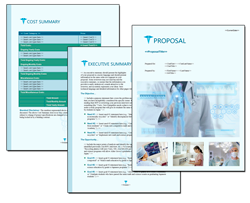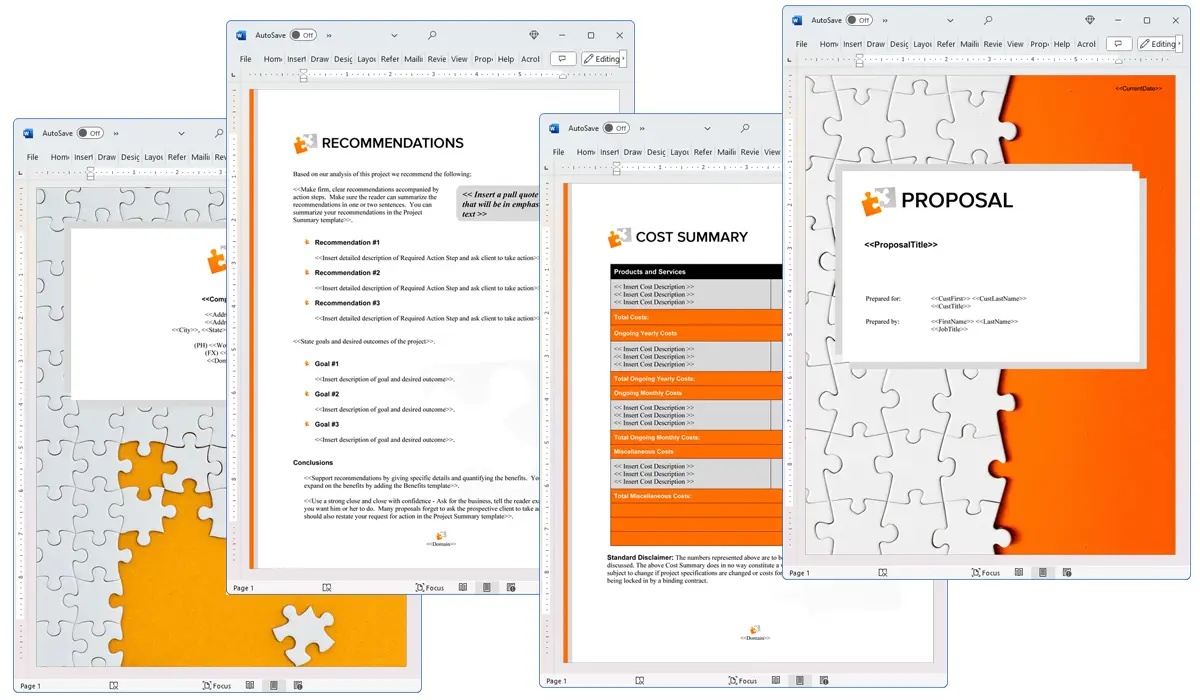What is the Reproducibility chapter used for?
Proposal Kit Professional Bundle adds more design themes, all six Contract Packs,
a project management library, and Expert Edition software.

Illustration of Proposal Pack Wireless #4
We include this Reproducibility chapter template in every Proposal Pack, along with thousands more. You assemble this chapter with others in various combinations to create custom-tailored business proposals, plans, reports, and other documents. Proposal Packs apply custom visual designs to the templates, giving the final documents a consistent professional finish.
 DOWNLOADABLE, ONE-TIME COST, NO SUBSCRIPTION FEES
DOWNLOADABLE, ONE-TIME COST, NO SUBSCRIPTION FEES
Overview of the Reproducibility Chapter
In the complex world of research proposals, the Reproducibility chapter is an important component that helps clarify the reliability and validity of the proposed scientific investigations. When drafting a research proposal, it is crucial to include a section that addresses how an independent third party could potentially replicate the study's results. This inclusion not only strengthens the proposal's credibility but also aligns with scientific standards that prioritize replicable outcomes. By integrating the Reproducibility chapter, businesses and researchers can communicate their commitment to producing transparent, trustworthy results that can withstand rigorous scrutiny.
How is the Reproducibility Chapter Used?
The Reproducibility chapter is used within a business proposal to provide detailed information on how the experiments or tests can be repeated by others to achieve the same results. This chapter serves as a testament to the integrity and methodological soundness of the research process outlined in the proposal. It is particularly crucial when seeking funding or approval from entities that value stringent scientific methods, such as government bodies, academic committees, or private foundations that emphasize research and development.
What is Included in the Reproducibility Chapter?
The Reproducibility chapter typically includes several key elements:
- Detailed Methodology: Clear, step-by-step descriptions of processes and experimental setups that allow for easy replication.
- Materials and Resources: Lists and sources of all materials used, ensuring that they are readily available for anyone attempting to reproduce the work.
- Data Analysis Techniques: Explanation of how the data will be analyzed, including software tools and statistical methods used.
- Potential Challenges: Discussion of any anticipated challenges that might affect reproducibility and how they can be addressed.
- Quality Control Measures: Strategies to ensure the consistency and accuracy of the data collected throughout the research process.
Use Case Examples for the Reproducibility Chapter
- Academic Research Proposals: Ensuring that studies contributing to academic knowledge can be independently verified.
- Pharmaceutical Testing: In proposals related to drug development, where reproducibility is crucial for regulatory approval.
- Environmental Science Studies: Proposals that involve variables such as climate conditions, where replicability supports the reliability of the findings.
- Engineering and Design: When proposing a new design or process, illustrating that results can be consistently achieved in different settings.
- Market Research: Demonstrating that survey methods and results can be replicated to verify consumer behavior patterns.
Key Takeaways
- The Reproducibility chapter is vital for demonstrating the scientific validity of research proposals.
- It ensures that the research methods and results can be independently replicated, enhancing the credibility of the proposal.
- This chapter should include detailed methodologies, resources, and data analysis techniques to facilitate reproducibility.
- It is particularly important in fields such as academic research, pharmaceuticals, environmental science, and any discipline involving systematic experimentation.
- Including a well-documented Reproducibility chapter can significantly increase the chances of a proposal's acceptance by emphasizing adherence to rigorous scientific standards.

Illustration of Proposal Pack Medical #7
 What Our Clients Say
What Our Clients SayI’ve been using Proposal Pack Wizard since 2000 and find it to be a highly organized and very useful way to create professional proposals quickly using Microsoft Word. I have saved countless hours trying to create proposals ’from scratch’."
Online Marketer / Product Manager / Trainer
 4.7 stars, based on 849 reviews
4.7 stars, based on 849 reviewsRelated Chapters

The Reproducibility chapter and other chapters are integrated into a Word document as illustrated here in the Proposal Pack Concepts #15 design theme. There are hundreds of design themes available, and every design theme includes the Reproducibility chapter template.
A proper business proposal will include multiple chapters. This chapter is just one of many you can build into your proposal. We include the complete fill-in-the-blank template in our Proposal Pack template collections. We also include a library of sample proposals illustrating how companies in different industries, both large and small, have written proposals using our Proposal Packs. This template will show you how to write the Reproducibility.
We include a chapter library for you to build from based on your needs. All proposals are different and have different needs and goals. Pick the chapters from our collection and organize them as needed for your proposal.
Using the Proposal Pack template library, you can create any business proposal, report, study, plan, or document.
The Wizard software includes an AI Writer, which will write the content of this and any other chapter of your document. Use the AI Writer to do the heavy lifting, writing the first draft of your proposal or business document in minutes.
 Ian Lauder has been helping businesses write their proposals and contracts for two decades. Ian is the owner and founder of Proposal Kit, one of the original sources of business proposal and contract software products started in 1997.
Ian Lauder has been helping businesses write their proposals and contracts for two decades. Ian is the owner and founder of Proposal Kit, one of the original sources of business proposal and contract software products started in 1997.By Ian Lauder
 Published by Proposal Kit, Inc.
Published by Proposal Kit, Inc.


 Cart
Cart
 Facebook
Facebook YouTube
YouTube Bluesky
Bluesky Search Site
Search Site